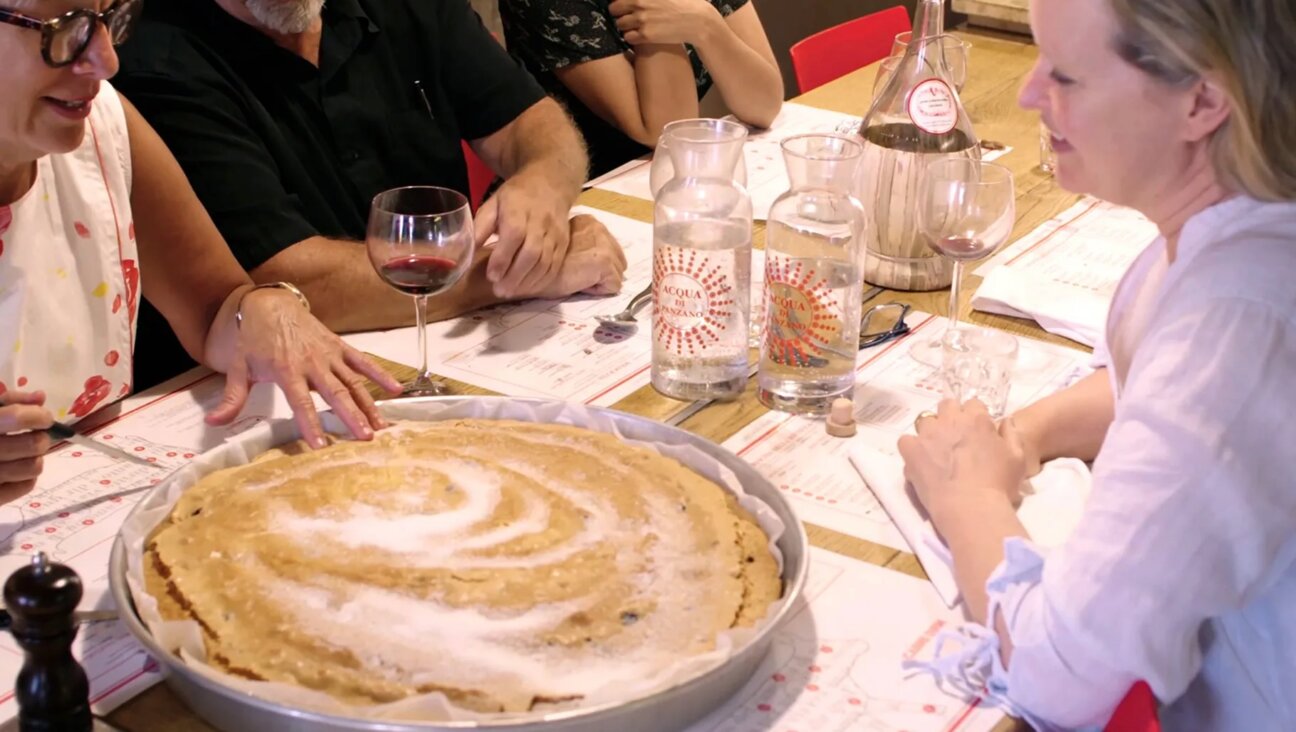How to Cook Weed-Laced Jewish Classics at Home

Graphic by Angelie Zaslavsky
If the idea of lacing traditional Jewish foods — gefilte fish, challah, matzo balls, latkes and kugel — with marijuana makes you wince, then skip right over this. But if reading about what certainly must be the first cookbook to feature such dishes piques your interest, read on.
All of these Jewish classics and more can be found in “The 420 Gourmet: The Elevated Art of Cannabis Cuisine” by JeffThe420Chef (Harper Wave).
Related
The author held what he called his first “Pot Shabbat” last year, catering it in the San Francisco Bay Area. His name and reputation were just getting out there back then, and around the same time he was offered a cookbook deal. This is the result.
While this is definitely not a Jewish cookbook, Jeff comes from an Orthodox background. (He does not identify that way anymore; the father of three left Orthodoxy around the same time that he came out as gay, post-divorce). None of this is mentioned in the book, but the inclusion of Jewish traditional foods is a giveaway that Jeff is Jewish; the Holiday Canna-Ham, Pigs in a Blanket and some other pork dishes not withstanding.

The 420 Gourmet Cookbook Image by Courtesy of HarperCollins Publishing
As one would expect in the current climate of legalized recreational and medicinal usage of marijuana in some states, cooking with cannabis has gotten much more sophisticated than it was in the old days, when you just threw some pot into a sauté pan with butter and used the butter to make brownies. While the basic technique of using butter or oil (or alcohol) to absorb the Tetrahydrocannabinol (THC, which is what causes the high) remains the same, there are now ways to minimize the “herbal” flavor, which is where Jeff comes in.
It must also be noted that research into how exactly marijuana helps certain medical conditions has advanced considerably, too. It is now understood that Cannabidiol (CBD) is the compound in pot that soothes pain, and therefore strains with a higher CBD-to-THC ratio are what should be used when cooking for people who use the drug medicinally.
As Jeff writes in the book’s introduction, “the key to a happy and successful edible experience relies on choosing the right strains and knowing how to properly calculate the levels of CBD and THC consumed.”
For the marijuana novice, the meat of the book opens with an explanation of the two main strains of marijuana, Indica verses Sativa, with Indica being the mellower of the two. But most marijuana available at either dispensaries or recreational shops is a hybrid of both. Jeff offers a two-page chart listing some of the most popular strains (like Blue Dream, OG Kush and Girl Scout Cookies) and giving their species, THC content, purported effects and what they’re used for. (Conditions include everything from muscle spasms to ADHD to depression to stress to fibromyalgia to headaches.)
While I found all of this to be somewhat interesting, the next part, I admit, kind of lost me. No doubt the pot connoisseur or science geek will find this stuff much more interesting than I did, but once we get into “decarbing,” which means decarboxylation — a fancy word for activating the THC or CBD since it can’t be consumed raw — I started nodding off a bit, wondering when we’d get to the food.
Exactly how Jeff creates his nearly tasteless oils and butters involves a multi-day process. So suffice it to say that you must start days in advance of actually making any food, first blanching the marijuana, decarbing and drying it, and then simmering and steeping it. At the end of these processes, you will have a good amount of what Jeff calls his canna-butter or canna-oil, which are the ingredients that appear in nearly every recipe in the book.
He also gives charts on how to estimate how much THC or CBD is in each serving, which is helpful in making sure you don’t serve anyone too much. In fact, each recipe has a sidebar offering the number of servings, prep time, cook time and approximate THC per serving.
Besides the inclusion of the Jewish dishes, the most notable thing about the book is that nearly every dish has been given a wacky name to signify the inclusion of pot.
Many dishes are given the prefix “canna” — so challah becomes “canna-challah” and latkes become “potato latkes with canna-pear crème fraiche.” But if every dish simply had “canna” inserted in the title things would get awfully repetitious, so there are dishes like “potzo ball soup,” and “stoned pepper pecan noodle pudding” (which we all know is kugel).
If you removed the pot from the equation, this would become a book of pretty standard American fare, with a mix of ethnicities represented in dishes such as “hazy thai wings” and “freaky fish tacos with lime-chipotle canna-aioli.” The Oaxacan mole recipe looks quite authentic with its list of 30 ingredients.
Jeff said he’s proud that his book also discusses “responsible dosing,” and that “it is also chock full of recipes that taste great even if you choose not to use infused butter or oil when making them.”
So yes, “The 420 Gourmet” can be used as a regular cookbook, too.
Given all this, it wasn’t a surprise to see a “Shapot dinner” listed in the entertaining menu section. The meal features infused gefilte fish, canna-challah, potzo ball soup and infused BBQ pulled brisket.
“This is the meal that makes my mom the proudest,” Jeff writes. “Time for an uplifting Shabbat dinner!”
Related
Alix Wall is a freelance writer and personal chef in Oakland, California, and the author of the blog TheOrganicEpicure. This article was first published on jweekly.com.






















